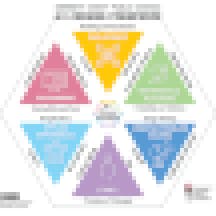How can we prepare students for a world increasingly influenced by artificial intelligence? If you are in the education field, it’s likely that you are dealing with AI in some way. “AI readiness” has emerged as a key focus area for forward-thinking educators. This approach goes beyond simply teaching students how to use AI tools; it aims to develop a comprehensive set of skills that will enable students to understand, critically evaluate and ethically engage with AI technologies. As AI becomes more pervasive, educators recognize that these skills are not just for future computer scientists or tech professionals. Rather, they are essential for all students as they prepare for higher education, careers and citizenship in an AI-infused world.
Recently, EdSurge spoke with Sallie Holloway, the Director of Artificial Intelligence and Computer Science for Gwinnett County Public Schools. Holloway is at the forefront of artificial intelligence and computer science education in one of Georgia’s largest school districts. Her position was created to support two major district-wide efforts: the Computer Science for All program and an ambitious AI-Future Readiness pilot program.
EdSurge: What does it mean for a student to be AI ready?
Holloway: When we talk about AI readiness, at its heart, we’re hoping to develop skill sets in students so they can be ethical and responsible users, developers and decision-makers when it comes to AI. We focus on our students’ workforce readiness: What does their future look like? If they spend 13 years with us, are we actually preparing them for that future? Since the growth of generative AI, we have made some updates to our framework, but they’ve been minimal because we’re trying hard to keep it focused on student skills and not tie it to specific technologies.
Why is it important for students to be AI ready?
At Gwinnett, we have a history of preparing students for their futures in innovative and meaningful ways. We knew we would be opening a new school due to population growth. Anytime you start a program or a school from the ground up, there’s an opportunity to innovate and try something different. That’s what led us down this road, honestly. We thought, “If we have the opportunity, what’s the next iteration? What do we really need to consider?”
After 13 years with us, if students have to go into a retraining program because they haven’t had access to or practice with some of the technologies in their next phase, we have done them a disservice. There is apprehension and perceived risk around talking about AI in K-12 education and what that means for our students, but honestly, I think the greater risk is not exploring it.
What misconceptions have you faced about the AI readiness framework?
One of the biggest misconceptions people have when they hear about our work is that we use a lot of AI. Honestly, that’s not the case. We are trying to pull back the curtain on AI and demystify it for our students. We want them first to be able to identify the use of AI and have, at minimum, a general understanding of how it works. You can’t make informed decisions if you don’t know how it works.
We also really dig into being critical of AI. We encourage students to question the tool’s agenda, data storage, privacy implications, origins and potential consequences. We are really trying to teach them how to question, poke holes and understand.
As students mature, we introduce them to AI tools but through the lens of: What’s the right way to use this? What are the ethical implications? Does this benefit us? Is there a better way we should be going about this?
We do not just have kids log in and use AI tools. Students examine AI through both a critical and optimistic lens, consider what it could do for the population and what they need to be aware of to ensure they are responsible and ethical.
What was the process for developing the framework?
We developed the framework with help from various people across the country. We started with industry and post-secondary partners, requesting, “You see AI in application; we want to learn from you.” Some were local professionals, but we also had interest from more prominent companies like Google, Apple, HP, Microsoft and Intel. Being in Georgia, we had the University of Georgia and Georgia Tech involved, as well as our local community college, Georgia Gwinnett College. We also received feedback from people at institutions like MIT and Stanford. These groups helped us create the initial thinking.
As we developed the framework, others contributed feedback and helped with iterations. Once we had a solid foundation, we took it to our advisory board, which included parents. After establishing our thinking and how to break it down across grade bands, we sought extensive teacher input. Teachers helped us determine what implementation would look like and whether we were on the right track.
The framework includes technical components like programming, data science, AI tools and robotics. But there’s also a strong emphasis on what we call “human-only skills” — ethics, creative problem-solving, design thinking and user experience. We focus on thinking about others — not just how something affects me but what it might do for someone else, good or bad.
We have a K-12 continuum that breaks down what this looks like at each grade band. The conversations in kindergarten look different from those in high school. Our classes still use the same standards. We cover the normal four core subjects and all electives, including fine arts, but they’re taught through the lens of our framework. Teachers make connections between what they’re teaching, the standards and the framework to bring in that real-world perspective and help students develop AI-related skills.

What advice would you give to other school districts looking to develop similar initiatives?
At the start, you really need leadership support and the ability, resources and culture to innovate. Having partnerships is also huge. They were key in getting this off the ground, especially when we created a three-course career pathway for high school students, which got pretty technical. These partnerships were essential in helping us think that through.
In-house collaboration is also vital, whether cross-divisional or from school to district. We involved everyone from superintendents to classroom teachers in this development, which helped create buy-in at all levels.
It’s essential to understand why you are doing this and what you are trying to solve. What does your community specifically need? Many versions of this could be right, depending on your situation.
When the conditions were right, we took steps to build, iterate, get feedback and try things. We collaborated closely with principals and teachers, evolving from demonstrating lessons to co-planning and supporting teacher-created content.
Being willing to come in and be vulnerable with them made a big difference. We would say, “No one has ever done this before. There’s not a curriculum we can call on. We’re creating this together. It’s okay if we make mistakes, but we will try together.” This approach was crucial in moving toward implementation, buy-in and, eventually, success.
This post is exclusively published on eduexpertisehub.com
Source link

